Bloom
YouTube. 6 Strategies For Teaching With Bloom's Taxonomy. 6 Strategies For Teaching With Bloom’s Taxonomy by TeachThought Staff Bloom’s Taxonomy can be a powerful tool to transform teaching and learning.
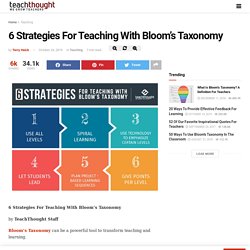
By design, it focuses attention away from content and instruction, and instead emphasizes the ‘cognitive events’ in the mind of a child. And this is no small change. For decades, education reform has been focused on curriculum, assessment, instruction, and more recently standards, and data, with these efforts only bleeding over into how students think briefly, and by chance. This stands in contrast to the characteristics of the early 21st-century, which include persistent connectivity, dynamic media forms, information-rich (digital and non-digital) environments, and an emphasis on visibility for pretty much everything.
Resources for Bloom's Taxonomy. My initial interest in linking Bloom's Taxonomy to apps stems from a deep-seated desire to meet the unique educational needs of gifted and talented students.
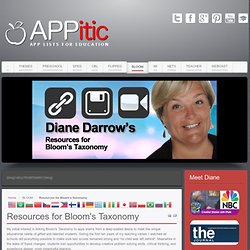
During the first ten years of my teaching career, I watched as schools did everything possible to make sure test scores remained strong and “no child was left behind”. Meanwhile in the wake of these changes, students lost opportunities to develop creative problem solving skills, critical thinking, and experience deeper, more meaningful learning. To add fuel to the fire, Gifted Programs began to slowly vanish from our schools. Like most of the public schools in California, the school district in which I was currently working cut their Gifted and Talented Program.
44 Prompts Merging Reflective Thinking With Bloom's Taxonomy. 44 Prompts Merging Reflective Thinking With Bloom’s Taxonomy by Peter Pappas It’s been four years since I first published my “Taxonomy of Reflection.”
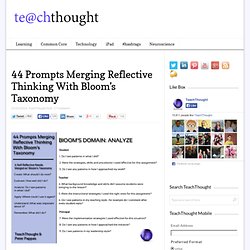
My interest in reflective thinking is rooted in a simple but powerful statement by Donald Finkel who wrote that teaching should be thought of as “providing experience, provoking reflection.” (Teaching with Your Mouth Shut) Most school mission statements include a reference to “fostering life-long learners.” Unfortunately, self-reflection is rarely taught in school.
I developed my Taxonomy of Reflection in an effort to provide a schema of prompts that could be used by students, teachers and administrators to hone their reflective skills. Seen through Bloom, that’s the equivalent of “Remembering: Retrieving, recognizing, and recalling relevant knowledge from short- or long-term memory.”
BloomQuestions_000.pdf. BLOOM'S TAXONOMY'S MODEL QUESTIONS AND KEY WORDS. 84 (And Counting) Bloom's Taxonomy Tools Worth Trying. New Bloom's Taxonomy Sheet with Over 80 Web Tools to Try Out. 4 Strategies For Teaching With Bloom's Taxonomy. 4 Strategies For Teaching With Bloom’s Taxonomy by TeachThought Staff Bloom’s Taxonomy can be a powerful tool to transform teaching and learning.

By design, it focuses attention away from content and instruction, and instead emphasizes the “cognitive events” in the mind of a child. And this is no small change. For decades, education reform has been focused on curriculum, assessment, instruction, and more recently standards, and data, with these efforts only bleeding over into how students think briefly, and by chance. This stands in contrast to the characteristics of the early 21st century, which include persistent connectivity, dynamic media forms, information-rich (digital and non-digital) environments, and an emphasis on visibility for pretty much everything.
A 3 Dimensional Model Of Bloom's Taxonomy -
A 3-Dimensional Model Of Bloom’s Taxonomy by TeachThought Staff Well, technically it’s a 2-dimensional representation of a 3-dimensional model, but being limited as we are in 2016 to 2D screens, it is what it is.
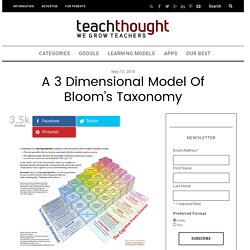
(Soon you’ll be able to 3D print what you see–download the plans and print it. Or play with it in virtual reality. Eventually a hologram you can manipulate digitally–pass around the room like a tennis ball, then fling it into the ether….) Rex Heer at Iowa State University, who created the graphic, explains: Among other modifications, Anderson and Krathwohl’s (2001) revision of the original Bloom’s taxonomy (Bloom & Krathwohl, 1956) redefines the cognitive domain as the intersection of the Cognitive Process Dimension and the Knowledge Dimension.
This document offers a three-dimensional representation of the revised taxonomy of the cognitive domain.
Bloom's Taxonomy Verbs - Free Classroom Chart. A New Fantastic Bloom's Taxonomy Wheel for iPad Apps. March 21, 2014 Today while I was browsing through my Twitter feeds I came across this fabulous Bloom's Taxonomy wheel of apps shared by Anthony.
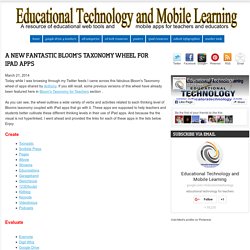
If you still recall, some previous versions of this wheel have already been featured here in Bloom's Taxonomy for Teachers section . As you can see, the wheel outlines a wide variety of verbs and activities related to each thinking level of Blooms taxonomy coupled with iPad apps that go with it. These apps are supposed to help teachers and students better cultivate these different thinking levels in their use of iPad apps. And because the the visual is not hyperlinked, I went ahead and provided the links for each of these apps in the lists below. Enjoy Create Evaluate Annalyse Apply Remember/understand This wheel is originally discovered on the website of Paul Hopkin's education consultancy site mmiweb.org.uk adopted by Allan Carrington.
New: Bloom's Taxonomy Planning Kit for Teachers. March 28, 2014 Somebody shared with me this wonderful Bloom's Taxonomy Planning Kit for Teachers and want you to have a look as well.
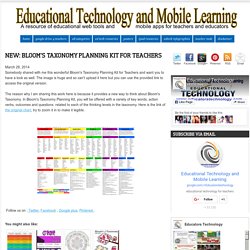
The image is huge and so can't upload it here but you can use the provided link to access the original version. The reason why I am sharing this work here is because it provides a new way to think about Bloom's Taxonomy. In Bloom's Taxonomy Planning Kit, you will be offered with a variety of key words, action verbs, outcomes and questions related to each of the thinking levels in the taxonomy. Here is the link of the original chart, try to zoom it in to make it legible.
A New Wonderful Wheel on SAMR and Bloom's Digital Taxonomy. The buzz that the Modern Taxonomy Wheel generated over the last couple of weeks has not yet died out and now we have a new updated wheel from the same guy Allan Carrington.
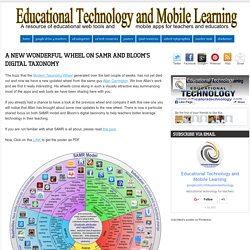
We love Allan's work and we find it really interesting. His wheels come along in such a visually attractive way summarizing most of the apps and web tools we have been sharing here with you. If you already had a chance to have a look at the previous wheel and compare it with this new one you will notice that Allan has brought about some new updates to the new wheel. There is now a particular shared focus on both SAMR model and Bloom's digital taxonomy to help teachers better leverage technology in their teaching. If you are not familiar with what SAMR is all about, please read this post. Now, Click on this LINK to get the poster as PDF.
20 Ways To Use PowerPoint With Bloom’s Taxonomy. 249 Bloom's Taxonomy Verbs For Critical Thinking. 249 Bloom’s Taxonomy Verbs For Critical Thinking by TeachThought Staff Bloom’s Taxonomy’s verbs–also know as power verbs or thinking verbs–are extraordinarily powerful instructional planning tools.
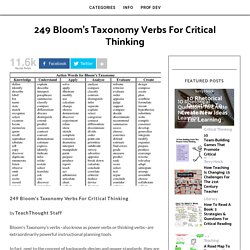
In fact, next to the concept of backwards-design and power standards, they are likely the most useful tool a teacher-as-learning-designer has access to. Why? They can be used for curriculum mapping, assessment design, lesson planning, personalizing and differentiating learning, and almost any other “thing” a teacher–or student–has to do. For example, if a standard asks students to infer and demonstrate an author’s position using evidence from the text, there’s a lot built into that kind of task. Though the chart below reads left to right, it’s ideal to imagine it as a kind of incline, with Knowledge at the bottom, and Create at the top.
Bloom's Digital Taxonomy for The Web. The Bloom's Taxonomy Periodic Table of Activities for Inspired Learning. Many of our readers have enjoyed the Bloom’s Taxonomy resources we’ve shared in the past, with the Bloom’s Taxonomy Verbs Poster heading up the list.
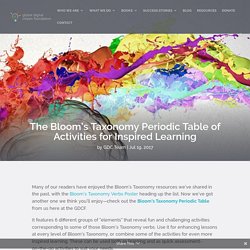
Now we’ve got another one we think you’ll enjoy—check out the Bloom’s Taxonomy Periodic Table from us here at the GDCF.
50 Resources For Teaching With Bloom's Taxonomy -
Simple suggestions for applying the taxonomy to kindergarten-level children. Lesson Planet: This source gives the goods on creating complete lesson plans using Bloom’s Taxonomy. Prezi: Enjoy this stylish Prezi presentation on Bloom’s Taxonomy. Iowa State U.: This is a wonderful tool to build learning objectives based on Bloom’s Taxonomy. The Differentiator: Teachers and students can work together using this source to design creative activities; provides resources, content and the verbs. Slideshare: Based on Bloom’s Taxonomy, this presentation shows how to apply the principles for high-order technology skills. The Literary Link: This is a list of book review questions to use in the classroom.










